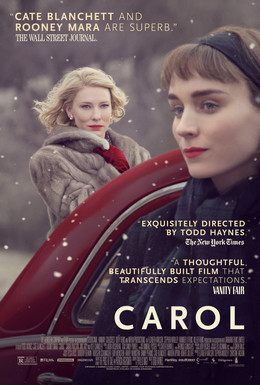Blanchett and Mara Shine in Visually Stunning ‘Carol’

What did cherry red lipstick do before Cate Blanchett was born? I’m sure loads of people must have worn it in years past, but it seems to have found its purpose when Blanchett decided to paint buckets of it on her ever-lovin’ puss for the title role in the new Todd Haynes film Carol.
Of course there’s a lot more to the movie—plot, characterization, drama—and we’ll get to that in a moment, but not before I spend some serious time rhapsodizing on the visual feast that is this film. Carol is set in the 1950’s so there’s a dazzling array of costumes (impeccably designed by Sandy Powell) involving period hats, gloves, shoes and smart dresses; Blanchett looks fabulous in everything she’s shown in and accessorizes all of it with a bright cherry red smile.
There are other worthwhile elements of the movie, but it’s hard to think about anything else when Blanchett’s face fills the screen. Her luminous, patrician beauty, and languid countenance could almost fool you into believing she’s the quintessential docile 50’s woman—except for that cherry red warning sign letting you know there’s danger behind that impossible cool.
There’s so much painfully exquisite beauty in this movie, I was afraid to sully it with my messy humanity—which may be the greatest strength and weakness of Carol.
1950’s Sexual Awakenings
The film is based on a 1948 novel entitled The Price of Salt which, when published, was credited as having been written by Claire Morgan … but that was merely a pseudonym for Patricia Highsmith.
You might know Highsmith as a writer of psychological thrillers, many of which have been turned into films, with the two most famous being Hitchcock’s Strangers on a Train and The Talented Mr. Ripley. When Highsmith submitted The Price of Salt to her publisher it was rejected so she found a new publisher for it and used the name Claire Morgan.
And all of that skullduggery was because the book is a lesbian—themed love story; Carol Aird is a New York socialite in the process of divorcing her husband Harge. In the middle of her Christmas shopping she meets a young sales clerk, Therese, and the two woman are immediately infatuated. But the courtship and excitement of “new love” is put in jeopardy when Harge threatens to deny Carol visitation rights of their daughter by exposing her as a lesbian unless she comes back to him. Welcome to the 50’s!
By all accounts the novel (which I’ve never read) is quiet and meditative, an extended interior monologue from Therese where she’s waking up to the world around her and the choices life presents.
Director Haynes places Carol more fully in the center of the story—and how could he not since you can’t look at anything else except Blanchett? Rooney Mara, playing Therese, is certainly no slouch in the looks or talent department herself, but Haynes is going after something else.
As he showed in a few of his previous films—Far From Heaven, Velvet Goldmine, and I’m Not There—Haynes is one of the most mannered artists working in the biz. He isn’t so much director in a conventional sense as he is a visual artist composing a picture from a mosaic; each carefully constructed element carefully assembled into a meticulously planned whole.
In a way, Far From Heaven is the companion piece to Carol; that 2002 movie starred Julianne Moore as a woman whose husband leaves her for another man. But as in Carol, the story wasn’t nearly as important as Haynes’ cinematic composition—Heaven was meant as a lush, visual tribute to Douglas Sirk, director of lush Hollywood melodramatic potboilers.
Carol isn’t visually quoting any director other than Haynes and his obsession with detail. Each swab if mascara, each A—line skirt, every stick of furniture, the cars, the drapes, the reflection of images in mirrors and on windows—nothing is ever less than perfect. And perfect in an “old money” sense; there’s nothing flashy or gaudy on display, it’s effortless, flawless and understated. A few times in the movie you might even find your breath taken away because of Haynes’ ruthless, studied composition.
And he’s managed to bring the cast into harmony with his visual style—these performances are all works in miniature, finely crafted and every bit as subdued and superb as the surroundings.
Blanchett, without seeming to even try, hooks us into the heart of the movie—this is a portrait of a woman discovering that she has a soul and is struggling to bring it into the light. Mara’s role as Therese is a very tricky proposition; Highsmith was upfront that the character was autobiographical but Highsmith was nothing if not an aloof cipher for most of her life. It’s to Mara’s great credit that she makes such an enigmatic figure as compelling as she does. Sarah Paulson plays Carol’s best-friend (and former lover) and with just the merest look of quiet pain tells us everything we need to know about their relationship, it’s past and the emotional toil. Playing the vengeful husband, Kyle Chandler could have made Harge a nightmare, instead we understand the loss and hurt he’s felt and how that spurs him to ugly choices.
Max Factor Would be Proud
But the star of the show is Cate’s lipstick, or rather it’s the metaphor of the show representing Haynes’ artistic manner and mannerism. The impossibly beautiful can be gorgeous and fascinating … but also be cold and a bit intimidating. While Carol may leave your heart wanting more, it’s a treasure for the eye and brain.
https://www.youtube.com/watch?v=H4z7Px68ywk
Ted Hoover is a Pittsburgh based critic.
Share on Social Media
Follow Entertainment Central
Latest Stories
Sign up for the EC Newsletter







